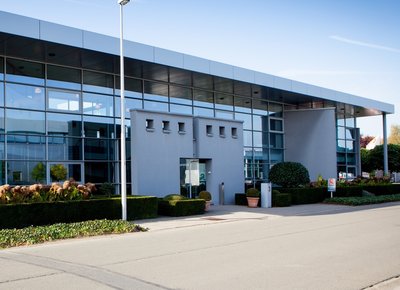Reynders Label Printing headquarters in in Boechout, Belgium
Domino Printing Sciences has successfully installed the first of its N600i digital colour label press at Reynders Label Printing in Belgium. The printer was also the beta test site for the press.
When it comes to quality and perfection, Reynders Label Printing knows just how to deliver. From its humble beginnings over half a century ago, when Emile Reynders founded the company in 1959 printing stationery in the family home, it has since expanded to become one of the leading label specialists in Europe.
Headquartered in Boechout, Belgium, with six specialised printing divisions and eight production facilities spread throughout Europe and Asia, the company prides itself in its commitment to delivering the very best in design and label printing in which innovation, quality and customer service are of paramount importance.
Today, Reynders, which remains a family-run business, has over 60 printing presses and more than 450 printing stations covering flexography, offset, letterpress, screen, dry toner, wet toner and inkjet printing technologies, enabling the company to offer one of the broadest ranges of label printing equipment for a host of applications. It has been this focus on maintaining its leading position through investment in the very latest label printing equipment that led to the installation of the first Domino N600i digital colour label press at its Belgium production facility.
Chief executive officer, Marc Reynders, explained, ‘Over the past few years, label printing has been facing new challenges with customers demanding ever tighter delivery deadlines, shorter average run lengths, more personalised data, but still the highest quality of end product.
As a result, we needed to find solutions that could not only cope with these changing demands, but that also means adjusting our service offering for our customers.’
Early introduction
The company first saw an early technology demonstration of the N600i at Ipex 2010 and was impressed. For a digital printing press, it offered much higher levels of productivity combined with improved print quality for inkjet. Mr Reynders said, ‘To take Reynders to the next level in digital label production, we needed a solution that could offer high quality digital printing at significantly increased speeds. The N600i was just what we were looking for.’
The four colour digital label press offers a native 600 dpi print resolution and uses one of the smallest drop sizes (6 pl) to deliver the highest quality output onto a range of coated paper and plastic label stocks and operates at speeds of 50-75 m/min. Combined with a standard 333 mm wide web width, it provides up to 1500 square metres of print per hour. In addition, by varying the droplet sizes delivered from a single print head combined with the composition of the ink, the press can reproduce a wide colour gamut including over 80% of the pantone colour range.
With so many label press technologies installed across Reynders’ multiple sites, the fact that Domino had integrated the Esko front end into its N600i added to its appeal and assisted with its integration.
Beta site
The installation presented its challenges, especially as the company had agreed to be a beta test site, but both the Reynders and Domino teams worked together to ensure any issues were addressed and the installation met all requirements. ‘It’s fair to say that with any beta site, installation can take longer than usual, but we are delighted with the outcome,’ confirmed Mr Reynders. ‘We always had complete confidence in Domino throughout the process. The team listened to our requirements, were extremely helpful in exploring ways to overcome any issues and conducted the installation with the utmost professionalism.’ Within a short time, the operations team had the press running at production speeds of 50 m/min and were using it for new mid-volume applications of up to 3000 metres, well above the 1000 metres limit it typically would schedule on digital machines.
The increased speed of throughput brought additional challenges for the operators, as it meant they could no longer manually check for rejects and quality of output, as was the procedure for the company’s slower running solutions. As a result, an automated vision system was installed to reduce operator intervention and adding further to production efficiencies.
To further develop the flexibility and capabilities of the press, Reynders and the Domino team are working together to develop new inks as well as review the integration of inline die-cutting technology within the production line.








